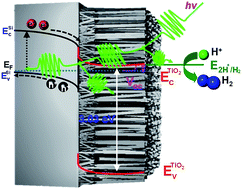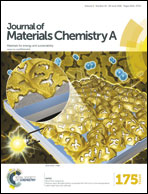A wafer-scale antireflective protection layer of solution-processed TiO2 nanorods for high performance silicon-based water splitting photocathodes†
Abstract
Sustainable and efficient conversion of solar energy to transportable green energy and storable fuels, hydrogen, represents a solution to the energy crisis and reduces the consumption of fossil fuels, which are mainly responsible for the rise in global temperature. Solar water splitting using semiconductors, such as silicon, is promising to satisfy the global energy demand by producing hydrogen molecules. However, the solar to hydrogen conversion efficiency of a silicon photoelectrode is suppressed by overpotential, high reflectance and/or instability in liquid electrolytes. Herein, we report the synthesis of multifunctional solution-processed TiO2 nanorods on a 4-inch p-silicon wafer with controllable heights and diameters for highly efficient water splitting photocathodes. The solution-processed passivation layer of TiO2 nanorods reduces the overpotential of the silicon photocathode due to its catalytic properties. The TiO2 NRs also dramatically improves the light absorption of silicon due to the antireflective ability of the nanorods. The reflectance of silicon is decreased from 37.5% to 1.4% and enhances the saturated photocurrent density. The Pt-decorated (1–2.5 nm diameter) TiO2 nanorods/p-Si photocathodes show a short circuit current density of up to 40 mA cm−2, an open circuit voltage ∼440 mV and incident photon to current conversion efficiency of >90% using 0.5 M H2SO4 electrolyte with simulated 1 sun irradiation. The heterostructure photocathodes are stable for more than 52 h without noticeable degradation and an ideal regenerative cell efficiency of 2.5% is achieved.


 Please wait while we load your content...
Please wait while we load your content...